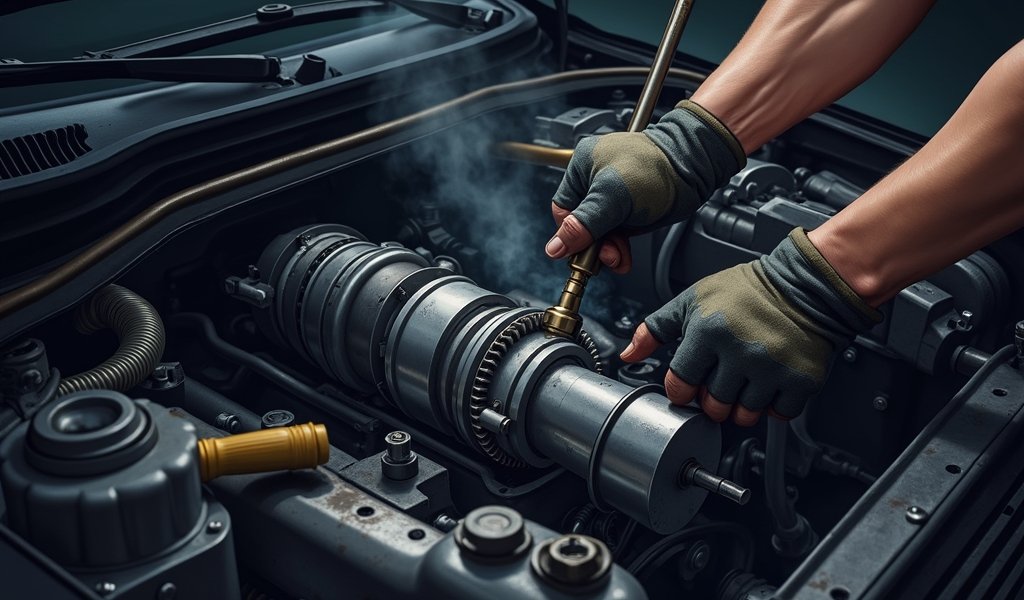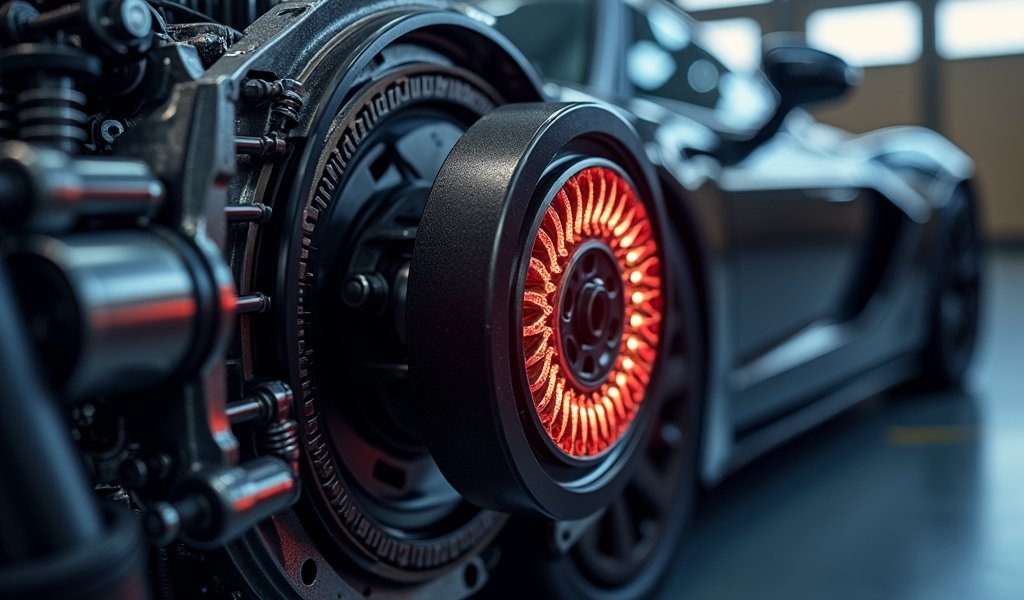Overview
This article provides a detailed guide on crankshaft trigger wheel alignment, explaining its critical role in engine timing, signs of misalignment, and step-by-step procedures for proper adjustment. It emphasizes that even minor misalignments can cause significant engine performance issues, while offering practical maintenance tips and troubleshooting advice for both DIY mechanics and professionals.
Table of Contents
- Understanding Crankshaft Trigger Wheels
- Why Proper Alignment Matters
- Signs of Misalignment
- Tools Needed for Alignment
- Step-by-Step Alignment Procedure
- Common Mistakes to Avoid
- Maintenance Tips
- Conclusion
- Frequently Asked Questions
Understanding Crankshaft Trigger Wheels
When it comes to modern engine management systems, the crankshaft trigger wheel might be the unsung hero of precise timing. This toothed wheel, also called a reluctor ring or tone ring, works alongside the crankshaft position sensor to tell your engine’s computer exactly where the crankshaft is in its rotation.
Think of it as a mechanical clock that your engine relies on to know exactly when to fire the spark plugs and inject fuel. Without this precision timing, your engine would be like an orchestra without a conductor—chaotic and inefficient.
Most trigger wheels feature a specific pattern of teeth with intentional gaps. Common configurations include the 60-2 wheel (58 teeth with a 2-tooth gap), 36-1 wheel (35 teeth with 1 gap), or 24-2 wheel (22 teeth with a 2-tooth gap). These gaps serve as reference points that help the engine identify a specific position in the rotation cycle.
The beauty of this system lies in its simplicity. As the crankshaft spins, the teeth pass by the sensor, generating electrical pulses. When the gap passes by, the absence of a pulse tells the computer, “Hey, I’m at this specific point in my rotation.” This information is crucial for the engine to maintain proper timing across all operating conditions.

Why Proper Alignment Matters
Let me tell you why getting this alignment right is absolutely critical. Engine timing is measured in degrees of crankshaft rotation, and even small misalignments can throw off your timing by several degrees. When you’re dealing with an engine that requires precision down to a single degree, that’s a big problem!
Picture this: your engine’s spark plugs are firing either too early or too late because the trigger wheel is telling your computer the wrong position. It’s like showing up for a blind date at the right place but on the wrong day—nothing good comes from it.
The consequences of improper alignment can range from minor annoyances to catastrophic failures:
- Reduced fuel economy (who wants to spend more at the pump?)
- Loss of power (that sluggish feeling when you hit the gas)
- Rough idle or stalling (embarrassing at traffic lights)
- Engine misfires (that concerning shudder you feel)
- Potential internal engine damage (ouch for your wallet)
I’ve seen cars come into my shop with mysterious performance issues that stumped other mechanics, only to discover a trigger wheel that was off by just a few degrees. Once properly aligned, these vehicles transformed from problem children to purring kittens.
Modern engines have remarkably tight tolerances, and as engine timing experts note, precision becomes even more critical in high-performance applications where every bit of efficiency matters.
Signs of Misalignment
How do you know if your trigger wheel alignment is off? Your car will usually tell you, though it might speak in a language that’s not immediately clear. Here are the common symptoms to watch for:
The check engine light is often your first clue. Codes like P0335 (Crankshaft Position Sensor Circuit), P0336 (Crankshaft Position Sensor Performance), or P0016-P0019 (Crankshaft/Camshaft Correlation) frequently point to trigger wheel issues.
Starting problems are another telltale sign. If your engine cranks but takes forever to start—or won’t start at all—the computer might be receiving incorrect position signals. It’s like trying to find your way with a map that’s upside down.
Pay attention to how your car runs once started. An engine that stumbles during acceleration, idles unevenly, or seems to have a split personality (running fine one moment and terribly the next) could be suffering from trigger wheel alignment issues.
I once had a customer bring in a Nissan that would run perfectly some days and act possessed on others. After checking everything else, we discovered the trigger wheel bolts had worked loose, causing the wheel to shift slightly during certain driving conditions. Tightening everything to spec solved the problem completely.
Unusual timing-related noises can also indicate problems. A pinging or knocking sound, especially under load, might mean your timing is off due to incorrect trigger wheel position. Your ears can be a valuable diagnostic tool!
Tools Needed for Alignment
Before you dive into this project, let’s make sure you’re properly equipped. Having the right tools not only makes the job easier but helps ensure you get accurate results.
For basic alignment work, you’ll need:
- Socket set and wrenches (including torque wrench)
- Timing light
- Feeler gauges
- Flashlight or work light (the brighter, the better)
- Factory service manual for your specific vehicle
- Marking pen or paint marker
For more precise work, consider adding these to your arsenal:
- Dial indicator with magnetic base
- Degree wheel
- Top Dead Center (TDC) finder tool
- Digital calipers
Don’t forget safety equipment! At minimum, you should have:
- Safety glasses
- Mechanics gloves
- Proper jack and jack stands if lifting the vehicle
The factory service manual is particularly important as alignment procedures vary widely between makes and models. What works perfectly for a Ford might cause problems in a Honda. As mechanics, we sometimes learn this the hard way!
A quality OBD-II scanner can also be invaluable for both diagnosing misalignment issues and verifying your repair. Some advanced scanners even allow you to monitor crankshaft sensor data in real-time, giving immediate feedback on your adjustments.
According to professional diagnostic technicians, having the right specialized tools can reduce diagnostic time by up to 70% when dealing with timing-related issues.

Step-by-Step Alignment Procedure
Ready to get your hands dirty? Let’s walk through aligning your crankshaft trigger wheel. I’ll break this down into manageable steps that even a novice mechanic can follow.
Safety First!
Always disconnect the battery before starting. This prevents accidental starter engagement, which could cause serious injury if your hands are near moving engine parts. Make sure the engine is cool, and you’re working in a well-lit area.
Step 1: Locate the Trigger Wheel
The location varies by vehicle. On many front-wheel-drive cars, it’s behind the crankshaft pulley. On others, it might be at the transmission bellhousing or the rear of the engine. Your service manual will show the exact location.
In some cases, you’ll need to remove components to gain access. This might include the timing belt/chain cover, starter motor, or transmission inspection plate. Take your time and keep track of all fasteners!
Step 2: Find Top Dead Center
For accurate alignment, you need cylinder #1 at Top Dead Center (TDC) on the compression stroke:
- Remove spark plugs to make rotating the engine easier
- Use a socket on the crankshaft bolt to turn the engine clockwise
- Monitor cylinder #1 (usually the front cylinder) with a TDC finder or long screwdriver through the spark plug hole
- When the piston reaches its highest point, verify with timing marks on the crankshaft pulley
Step 3: Check Current Alignment
With the engine at TDC, examine the relationship between the trigger wheel and sensor:
- The “missing tooth” gap should align with a specific reference point (check your service manual)
- Measure the air gap between the sensor and wheel teeth (typically 0.020″-0.060″)
- Look for damage, corrosion, or bent teeth that might affect sensor readings
Step 4: Make Necessary Adjustments
If alignment is off:
- Loosen (don’t remove) the mounting bolts or screws that secure the trigger wheel
- Carefully rotate the wheel to the correct position, keeping the reference marks aligned
- Hold it firmly in position while tightening the fasteners
- Tighten in a star pattern to ensure even pressure, using your torque wrench to the specified value
For press-fit wheels that can’t be directly adjusted, you might need to modify the sensor mounting position instead. Some aftermarket wheels come with adjustment slots specifically for fine-tuning.
Step 5: Verify Your Work
After tightening everything:
- Rotate the engine by hand through at least two complete revolutions
- Confirm it returns precisely to TDC with timing marks aligned
- Check that the trigger wheel maintains proper alignment throughout rotation
- Verify the air gap remains consistent as the wheel turns
Some engines with a camshaft timing chain will require additional verification to ensure proper cam-to-crank timing after any work in this area.
Step 6: Final Testing
Once everything’s buttoned up:
- Reconnect the battery
- Start the engine and listen for unusual noises
- Check for check engine lights
- Test drive to verify smooth operation under various conditions
- Use your scanner to check for timing-related error codes
I remember working on a Subaru that had a persistent misfire after a timing belt replacement. After hours of troubleshooting, we discovered the trigger wheel had been installed one tooth off. A quick adjustment transformed the car’s performance instantly—one of those satisfying “aha!” moments we mechanics live for.
Common Mistakes to Avoid
Even experienced mechanics can slip up when working with trigger wheels. Here are some pitfalls I’ve either witnessed or (embarrassingly) fallen into myself:
Rushing the job is the number one mistake. Precision requires patience. I’ve seen plenty of repeat repairs because someone tried to rush through the initial alignment. Take your time, especially when tightening fasteners that could shift your carefully positioned wheel.
Ignoring the factory specs is asking for trouble. Each engine has specific alignment requirements. What works on one model might cause problems on another. Always reference your service manual rather than relying on “looks about right” eyeballing.
Failing to check for damage can lead to frustrating results. Before realignment, inspect the wheel thoroughly for bent or broken teeth, corrosion, or cracks. A damaged wheel will never give reliable readings, no matter how perfectly you align it.
Overlooking the sensor itself is surprisingly common. The trigger wheel might be perfect, but if the sensor is damaged or its wiring is compromised, you’ll still have problems. Check the sensor mounting, connection, and wiring as part of your procedure.
Forgetting to verify alignment through a complete rotation can hide problems. Some wheels might align perfectly at TDC but shift or wobble at other positions. Always rotate the engine through at least two complete revolutions after adjustment.
Not using a torque wrench can lead to either loose fasteners (which will shift over time) or overtightened ones (which can distort the wheel). Proper torque is critical for maintaining your alignment long-term.
As the experts at Motor Magazine explain, many timing issues stem from improper installation rather than component failure.
Maintenance Tips
Once you’ve got your trigger wheel properly aligned, how do you keep it that way? Here are some maintenance practices that will help ensure long-term reliability:
Regular visual inspections can catch problems early. Whenever you’re working in the timing belt/chain area, take a moment to check the trigger wheel and sensor for signs of damage, corrosion, or loose mounting hardware.
Keep an eye on your engine performance. Any changes in starting behavior, idle quality, or acceleration response could indicate a developing alignment issue. Don’t ignore these early warning signs!
Consider trigger wheel maintenance during timing belt/chain service. Since you’ll likely have access to the area anyway, it’s the perfect opportunity to inspect and verify proper alignment.
Protect against corrosion in harsh environments. A light coating of corrosion inhibitor on steel trigger wheels can prevent rust that might otherwise affect sensor readings. Just be sure not to apply anything that might attract debris.
If you modify your engine for performance, remember that changes to the rotating assembly might affect trigger wheel operation. Higher RPMs can amplify even minor vibration issues, so upgraded hardware might be necessary.
For vehicles that see track use or high-performance driving, more frequent inspections are warranted. The increased stress can cause fasteners to loosen over time.
I had a customer with a modified Mitsubishi Evo who experienced intermittent misfires at high RPM. After multiple failed attempts by other shops to solve the problem, we discovered that engine vibration was causing slight movement in the trigger wheel at higher revs. Upgrading to stronger mounting hardware and applying thread locker solved the issue permanently.
Conclusion
Proper crankshaft trigger wheel alignment might seem like a small detail in the grand scheme of engine management, but it’s one of those critical foundations that everything else depends on. Think of it as making sure your watch keeps perfect time—without it, all your carefully scheduled plans fall apart.
The good news is that once properly aligned, most trigger wheels stay that way for the long haul. The investment of time and attention to detail pays off with reliable performance, improved fuel economy, and the prevention of potentially expensive engine damage.
Whether you’re troubleshooting an existing problem, performing routine maintenance, or upgrading for performance, understanding the importance of this component and how to work with it properly puts you ahead of the game.
Remember, modern engines operate within incredibly tight tolerances, and precision matters. Take your time, follow the procedures for your specific vehicle, use the right tools, and double-check your work. Your engine will thank you with smooth, reliable performance for miles to come.
And if you ever find yourself stuck or uncertain, don’t hesitate to consult with a professional. Some investments in expert help save money in the long run by preventing costly mistakes. Happy wrenching!
Frequently Asked Questions
How do I know if my trigger wheel is misaligned?
Common symptoms include hard starting, rough idle, engine misfires, poor acceleration, and check engine lights with crankshaft position sensor codes. Your vehicle might also exhibit inconsistent performance that seems to come and go.
Can I drive with a misaligned trigger wheel?
While you might be able to drive temporarily, it’s not recommended as it can cause decreased fuel economy, poor performance, and potential engine damage. Continuing to drive with severe misalignment could lead to catalytic converter damage from unburned fuel.
How often should trigger wheel alignment be checked?
Inspect it whenever you replace timing belts/chains or perform major engine work. For most vehicles, that means every 60,000-100,000 miles unless you notice symptoms earlier.
Do all vehicles have the same type of trigger wheel?
No, trigger wheels vary widely between manufacturers in tooth count, pattern, and location. Common configurations include 60-2, 36-1, and 24-2 patterns, but always consult your specific vehicle’s service manual.
Can I adjust the trigger wheel alignment myself?
Yes, with the right tools and knowledge, many DIYers can successfully align trigger wheels. Just be sure to follow the factory specifications precisely and take your time to ensure accuracy.

